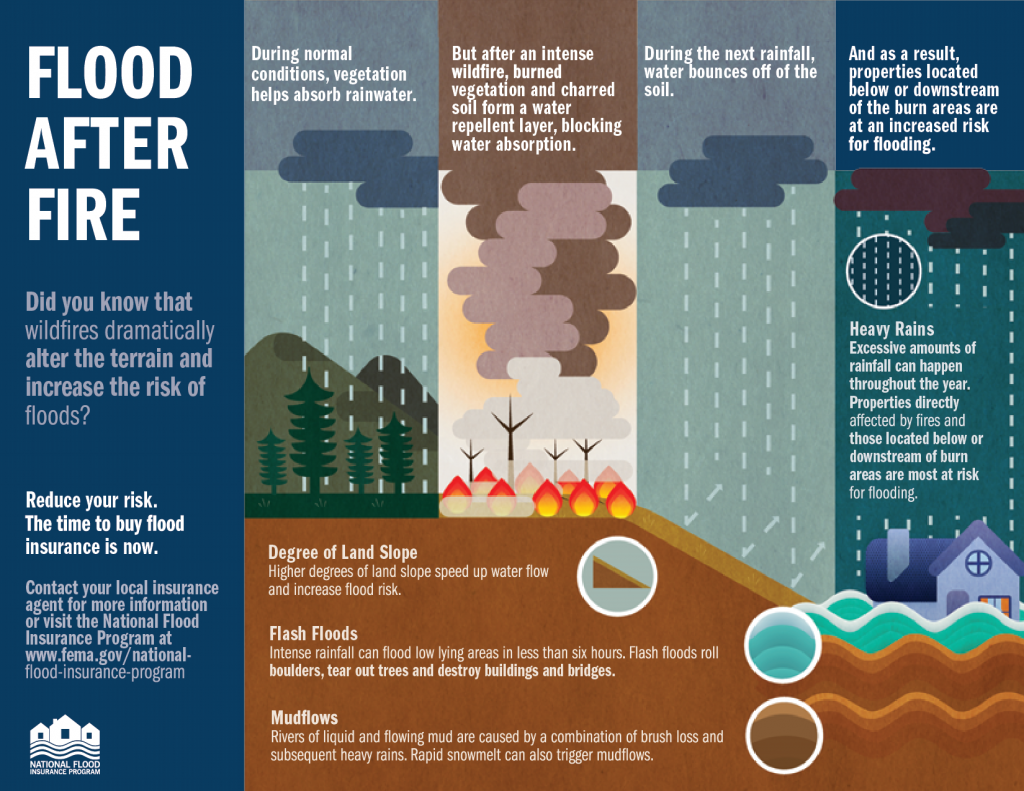Flood After Fire: When the flames are out, a threat remains
FLOODING FROM BURN SCARS
The community of Marysvale may be at greater risk for flooding and debris flow due to the 2024 Silver King fire which burned over 18,000 areas in July. The US Forest Service Burn Area Emergency Response (BAER) team together with USGS conducted a debris flow analysis of the burn scar on federal land to determine levels of increased risk.
Many people are not aware of the threat of flood that comes after fire. Wildfires remove vegetation and leave the ground charred and unable to absorb water. This creates ideal conditions for flash flooding and mudflows when there is rainfall or snowmelt, even in areas that are not considered high-risk flood zones. Properties directly affected by fires and those located below or downstream of burn areas are most at risk.
The time to act and prepare is now.
If you live below a burn scar:
- Contact your insurance agent and ask about flood insurance. It is a SEPARATE policy from your homeowners policy. Your regular homeowners policy may NOT cover flooding.
- New flood insurance policies typically take 30 days to go into effect.
- If you live below a burn scar, plan to maintain an flood insurance policy for at least 3-5 years as the watershed recovers after the wildfire.
- Pay attention to weather reports, specifically flood watches and warnings. It doesn’t take much rain to bring down a hillside after it’s been burned.
- Be prepared to evacuate.
- Don’t let anyone sleep in a basement during storms. A debris flow can fill basements with water and mud in a minute, blocking doors and trapping people.
- Bring important documents above basement level when there is a storm threat. Don’t let them get destroyed by a debris flow.
- Turn Around, Don’t Drown! Do NOT drive through a flooded area. If you come upon a flooded road, turn around and go another way. More people drown in their cars than anywhere else.
- If your car stalls, abandon it immediately and climb to higher ground. Many deaths have resulted from attempts to move stalled vehicles.
- Don’t walk through flooded areas. As little as six inches of moving water can knock you off your feet.
- Stay away from downed power fines and electrical wires. Electrocution is another major source of deaths in floods. Electric current passes easily through water.
- Look out for animals – especially snakes. Animals lose their homes in floods, too. They may seek shelter in yours.
- If the waters start to rise inside your house before you have evacuated, retreat to the second floor, the attic, and if necessary, the roof.
- Take dry clothing, a flashlight and a portable radio with you. Then, wait for help.
- Don’t try to swim to safety; wait for rescuers to come to you.
- If outdoors, climb to high ground and stay there.
Wade Mathews is the public information officer for the Utah Division of Emergency Management.
wmathews@utah.gov


If you found this news entry interesting, please consider sharing it through your social network.